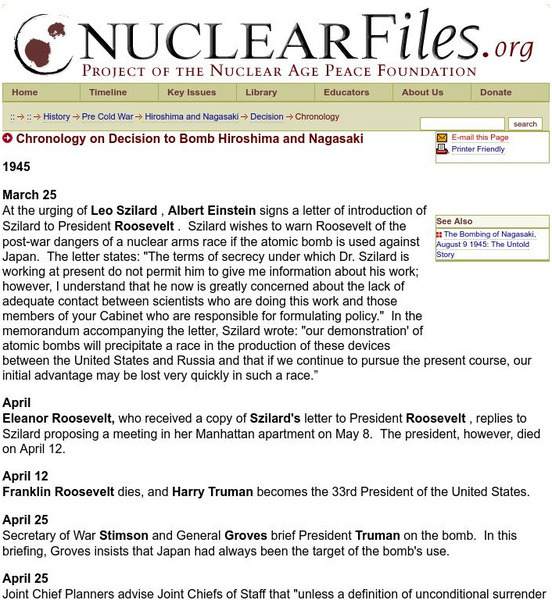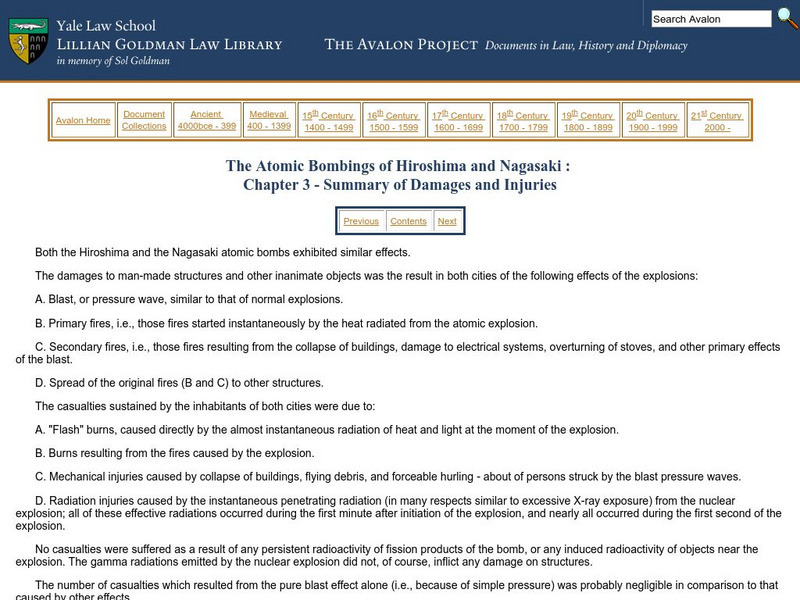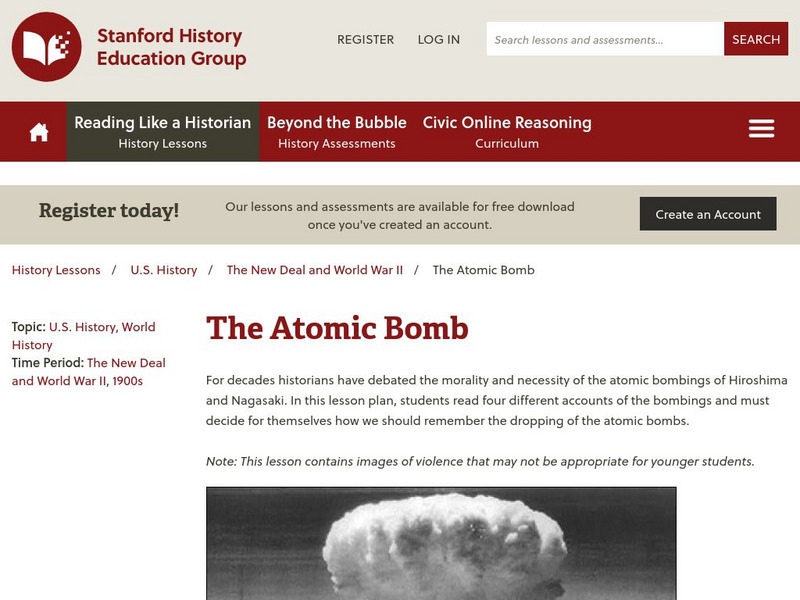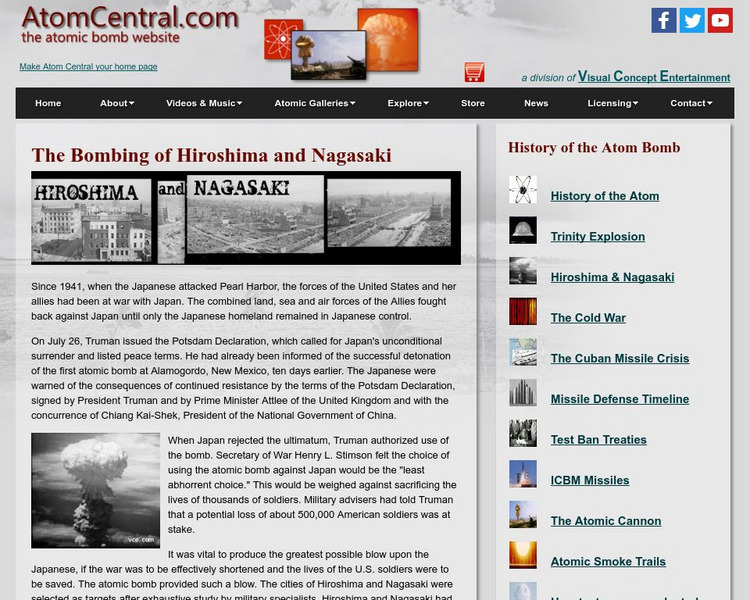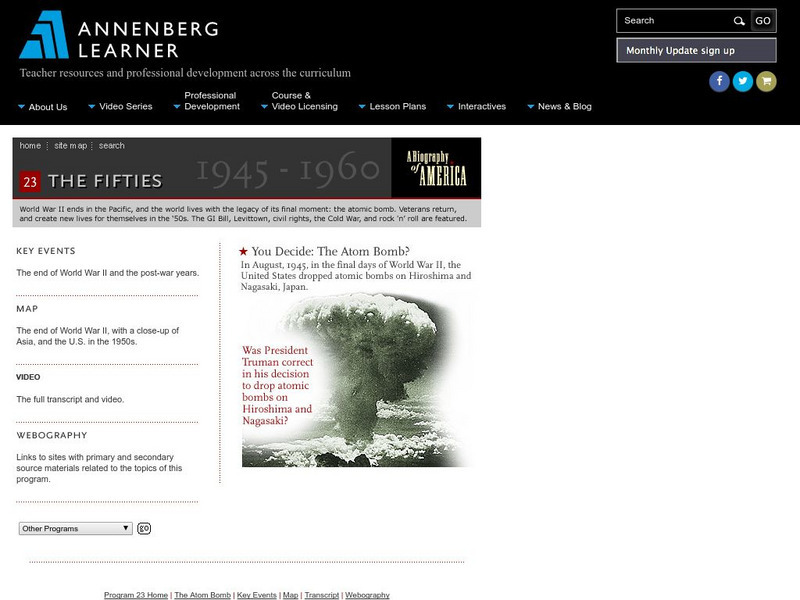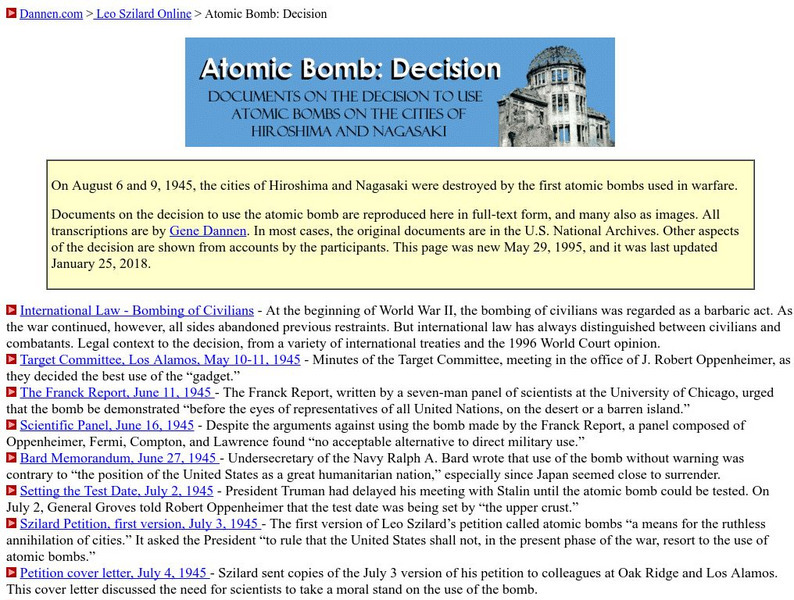Other
World Nuclear Association: Hiroshima, Nagasaki, and Subsequent Weapons Testing
This article has information about the bombings of Hiroshima and Nagasaki. Additional information about the measures that have been taken about atomic warfare and testing since the bombings included.
Other
Hiroshima & Nagasaki 60 Years Later
Detailed background information and a collection of resources are provided to help one understand the history of the bombings of Hiroshima & Nagasaki. Material consists of original texts, eyewitness accounts, photographs, videos, and...
World Wide School
World Wide School: Hiroshima and Nagasaki: Chapter Vii: The Attacks
This page describes the destruction of the cities after the U.S. bombed Hiroshima and Nagasaki. The information comes from Chapter 7 of the book The Atomic Bombings of Hiroshima and Nagasaki by The Manhattan Engineer District, published...
World Wide School
World Wide School: Atomic Bombing of Hiroshima and Nagasaki
This online book provides a detailed account of the U.S. creation of the atomic bomb, the attack on Hiroshima and Nagasaki, and the aftermath. Written by The Manhattan Engineer District, a military committee, in 1946.
Other
Hiroshima and Nagasaki Remembered
History, archival film footage, photographs, pictures, maps, and biographies of people connected to the bombings, and related documents and resources.
Mocomi & Anibrain Digital Technologies
Mocomi: Hiroshima and Nagasaki Bombing
Features interesting facts about the Hiroshima and Nagasaki bombing in 1945.
Other
Nuclearfiles.org: Chronology on Decision to Bomb
This detailed chronology of the events and communication of 1945-1946 shows Truman's role in the process of the decision to drop the world's first atomic bomb used in warfare upon Hiroshima and then the second upon Nagasaki. Also...
Yale University
Summary of Damages and Injuries
Outlines the devastation the atomic bomb had on Hiroshima and Nagasaki, Japan.
Stanford University
Sheg: Document Based History: Reading Like a Historian: The Atomic Bomb
[Free Registration/Login Required] How necessary was it for the United States to drop the atomic bombs on Nagasaki and Hiroshima in World War II? In this lesson, students will study varying accounts and develop their own opinions of...
Ohio State University
Osu History Teaching Institute: The Manhattan Project
Students will discuss the role of technology of the atomic bomb and explore the destruction of Nagasaki and Hiroshima during WWII. Students will then outline some of the social and political changes that resulted from the Manhattan Project.
Other
Atom Central: The Bombing of Hiroshima and Nagasaki
Read this detailed account of the decision and action to drop two atomic bombs on Japan after the attacks on Pearl Harbor.
World Wide School
World Wide School: Chapter Iii: Summary of Damages and Injuries
This page details the damages and injuries caused by the Hiroshima and Nagasaki atomic bombs. The information comes from Chapter 3 of the book The Atomic Bombings of Hiroshima and Nagasaki by The Manhattan Engineer District, published in...
Digital History
Digital History: The Aftermath of the Decision [Pdf]
A touching and horrifying description of the devastation caused by the dropping of atomic bombs on Hiroshima and Nagasaki, which brought about the surrender of Japan in World War II. Suggested student exercises accompany the information....
Annenberg Foundation
Annenberg Learner: A Biography of America: The Fifties 1945 1960
World War II ends with the legacy of its final moment: the atomic bomb. After reading comprehensive background material, interactive feature lets you decide if President Truman was correct in his decision to drop atomic bombs on...
Other
Dannen.com: Atomic Bomb Decision
This site has information about the bombings of Nagasaki and Hiroshima. The information is detailed and in depth. Contains many links to related sites.
Science Struck
Science Struck: Atomic Bomb Facts
Discusses lost nuclear weapons, the power of an atomic bomb, the bombing of Hiroshima and Nagasaki, the development of the atomic bomb, the making of the hydrogen bomb, the detonation of a hydrogen bomb by Russia in 1961, and the status...
University of California
University of California, Los Angeles: Children of the Atomic Bomb
In his own words, an American physician describes the devastating effects of the atomic bomb dropped in Nagasaki during World War II. Included is an online collection of images of the aftermath, videos, lesson plans, oral history...
PBS
Pbs: The War: The Atomic Bomb
At the online companion site of the PBS documentary series "THE WAR," read three descriptions of the atomic bomb and its use.
National Geographic
National Geographic: Society: World War Ii in the Pacific
This interactive timeline takes you through the war in the Pacific during WWII. Vibrant pictures, primary source videos, and explanations accompany each important date. Follow the war in the Pacific from events leading to war to the...
OpenStax
Open Stax: World War Ii 1941 1945: The Pacific Theater and the Atomic Bomb
Looks at America's involvement in the Pacific Campaign, and the decision to use the atomic bomb against Japan and the impact it had.
Yale University
Yale Avalon Project: Radiation Injuries in Japan
Site from Yale provides detailed information about the radiation sickness that swept through the bombed areas of Japan after WWII. Detailed and thorough analysis.
Other
Los Alamos National Laboratory
The official website of the Los Alamos National Laboratory. You will find the history of the laboratory as well as many of the key figures. There is also an interactive history of the Manhattan Project. Be sure to check out the photo...
National Cable Satellite Corporation
C Span Classroom: World War Ii the Decision to Use the Atomic Bomb
This video provides Lt. Col. Grant Weller, who describes the decision of the United States to use the atomic bomb on Japan to end World War II. Student questions are provided to assess their understanding of the information.
Raleigh Charter High School
Mrs. Newmark's Page: World War Ii Chronology 3
This activity has you put events of the end of World War II in chronological order.






